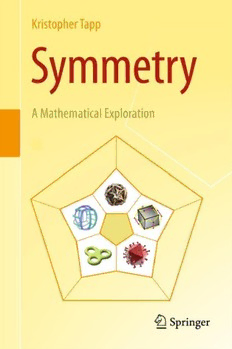
Symmetry: A Mathematical Exploration: Tapp PDF
Preview Symmetry: A Mathematical Exploration: Tapp
Symmetry Kristopher Tapp Symmetry A Mathematical Exploration Kristopher Tapp Department of Mathematics Saint Joseph’s University 5600 City Ave. Philadelphia, PA 19131 USA [email protected] ISBN 978-1-4614-0298-5 e-I SBN978-1-4614-02 99-2 DOI 10.1007/ 978-1-4614-0299-2 Springer New York Dordrecht Heidelberg London LibraryofCongressControlNumber:2011940690 M athematics Subject Classification (2010): 00-01, 00A06, 00A09, 00A66, 00A99, 20-01, 51-01, 97G40, 97U20 © Springer Science+Business Media, LLC 2012 All rights reserved. This work may not be translated or copied in whole or in part without the written permission of the publisher (Springer Science+Business Media, LLC, 233 Spring Street, New York, NY 10013, USA), except for brief excerpts in connection with reviews or scholarly analysis. Use in connection with any form of information storage and retrieval, electronic adaptation, computer software, or by similar or dissimilar methodology now known or hereafter developed is forbidden. The use in this publication of trade names, trademarks, service marks, and similar terms, even if they are not identified as such, is not to be taken as an expression of opinion as to whether or not they are subject to proprietary rights. Printed on acid-free paper Springer is part of Springer Science+Business Media (www.springer.com) (cid:19)(cid:148)(cid:135)(cid:136)(cid:131)(cid:133)(cid:135)(cid:3) Symmetry is a ubiquitous concept in mathematics and science. Certain shapes and images seem more symmetric than others, yet it is not immediately obvious how to best measure and understand an object’s symmetry. In fact, the quest to more precisely understand symmetry has been a driving force in science and mathe- Vitruvian Manby Leonardo Da Vinci matics, and will form the central theme of this book. You will learn the ways in which mathe- maticians study the topic of symmetry. If you are curious about the mathematical patterns underlying the symmetry that you observe in the phy- sical world, then this book is for you. Why are honeycombs hexagonal? Why are bubbles spherical? Why did the HIV virus evolve its icosahedral shape? What is the shape of the universe, and how might this shape be An icosahedral HIV virus related to the shape of a virus? How can one understand the symmetry of molecules or crystal formations? How might the symmetry in a painting enhance its artistic appeal? Parts of these answers are found in other disciplines – biology, chemistry, physics, and art – but the common thread is mathematics. Mathematics provides the tools to understand and classify the possible types of symmetry that v vi Preface objects may possess, which is a crucial prerequisite for addressing questions like those above. No background beyond high school level algebra is required to read this book. The mathematical topics are drawn from diverse fields including graph theory, abstract algebra, linear algebra and topology, all of which are essential to rigorously study symmetry. Although some of these topics are advanced, the presentation in this book is intended to be precise and rigorous, yet accessible to a general audience. The only real pre- requisite is that you discard any preconceived notions of what math is and is not, and begin this mathematical journey with an open mind and a willingness to begin actively doing what mathematicians do: dis- covering patterns, invent- ing precise language for discussing the mathe- matical principles under- lying those patterns, forming conjectures, and eventually proving beauti- ful theorems. Honeycomb photo by Ken Tapp Intended Audience This book is primarily intended as a textbook for a one- semester math course for math or non-math majors, including humanities majors, with the goal of encouraging effective ana- lytical thinking and exposing students to elegant mathematical ideas. It includes some of the topics which are commonly found in sampler textbooks, such as Platonic solids, Euler’s formula, irrational numbers, countable sets, permutations and a proof of the Pythagorean Theorem. All of these topics serve a single compelling goal: to understand the mathematical patterns under- lying the symmetry that we observe in the physical world. I hope Preface vii that students from all majors will enjoy the many beautiful mathematical topics herein, and will come to better appreciate the powerful cumulative nature of mathematics as these topics are woven together into a single story about symmetry. Instructor resources, including PowerPoint lectures and access to all images in the book, can be found at http://www.sju.edu/ ~ktapp/Symmetry Acknowledgments I am delighted to thank Paul Klingsberg and Susan Ramee for suggesting many improvements to the exposition. I am also grateful to the following artists who generously permitted me to include their images in my book: Vladimir Bulatov, Robert Fathauer, Brian Sanderson, Paul Söderholm and Ken Tapp. Taablle of Nootaatioonn D = thee nnth dihheddrall grouup = tthee syymmeetryy grrouup of a rreggulaar nn n-ggonn. Itt haas 22n tottal mmeembberrs (nn rootaations and nn flips)). C = thee nnth cycclicc grouup = tthee syymmmeetryy grouup of ann orriennteed nn reggulaar n-ggonn. It haas n tottal memmbeer (alll rootaations)). AA shoorthhannd nottation forr thhese nn rootattionns iis {0, 1, 22, ……, n––1}. P = thee nnth peermmutaatioon grooupp == tthe coolleection off all pperrmuu- nn tationns oof nn orrdeeredd thhinggs. It hhass n! tootal meemmbeers. A = thee nnth alternaatinng grooupp == thee ccollecttionn oof alll eeveen nn permutaatioons of n oordereed tthinngss. Itt haas hhalf thhe ssizee oof PP . n Z = {…… –33, ––2, –1, 0, 1, 2,, 3, ……} == thhe sset of all inttegeerss. Q = thee seet oof aall rratioonaal nnummbeers (frracttionns llikee 8//5 aandd –33/77). R = thee seet oof aall rreal nuumbers ((rattionnal annd irrationnal nuumbberrs). Rnn = nn-dimeenssionnal Euucliddeaan spacee. FForr exxammple, R22 is caalleed thee pllane aandd R33 iss caalleed sspaace. ix
